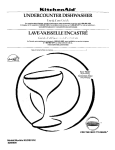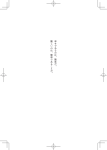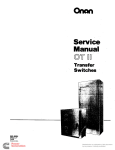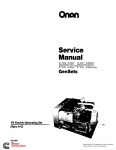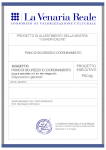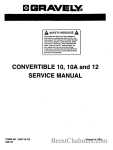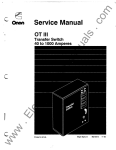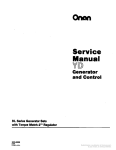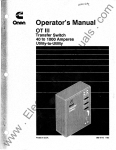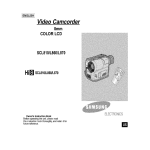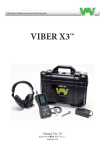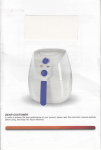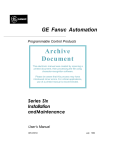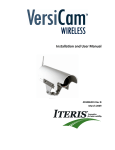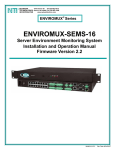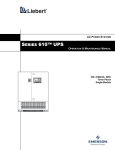Download 943-0016 Onan YHB Alternator Service manual (02
Transcript
Caution: This document contains mixed page sizes (8.5 x 11 or 11 x 17), which may affect printing. Please adjust your printer settings according to the size of each page you wish to print. Generator YHB Generator with Torque Match4 Regulator'" 943-0016 2-86 . Printed in USA. Redistribution or publication of this document, by any means, is strictly prohibited. Safety Precaytions The following symbols in this manual highlight conditions potentially dangerous to service personnel,or equipment. Read this manual carefully. Know when these conditions can exist. Then take necessary steps to protect personnel as well as equipment. Do not work on this equipment when mentally or physically fatigued. GUARD AGAINST ELECTRIC SHOCK This symbol warns of Immediate hazards which will result in severe personal Injury or death. . c Disconnect electric power before removing protective shields or touching electrical equipment. Use rubber insulative mats placed on dry wood platforms over floors that are metal or concrete when around electrical equipment. Do not wear damp clothing (particularly wet shoes) or allow skin surfaces to be damp when handling electrical equipment. This symbol refers to a hazard or @@!?%&I unsafe practice which can resuit in severe personal Injury or' death; This symbol refers to a hazard or @@@%I unsaie practice which can resuit in personal Injury or product or property damage. Disconnect batteries to prevent accidental engine start. Jewelry is a good conductor of electricity and should be removed before working on electrical equipment. PROTECT AGAINST MOVING PARTS Use extreme caution when working on electrical components. High voltages cause injury or death. Avoid moving parts'of the unit. Avoid use of loose jackets, shirts or sleeves due to danger of becoming caught in moving parts. , Follow all state and local codes. To avoid possible personal injury or equipment damage, a qualified electrician or an authorized service representative must perform installation and all service. Make sure all nuts and bolts are secure. Keep power shields and guards in position. If you must make adjustments while the unit is running, use extreme caution around hot manifolds, moving parts, etc. ' IAWARNING I EXHAUST GAS IS DEADLY! Exhaust gases contain carbon monoxide, an odorless and colorless gas. Carbon monoxide is poisonous and can cause unconsciousness and death. Symptomsof carbon monoxide poisoning can include: Dizziness Nausea. Headache Weakness and Sleepiness , 0 0 0 0 0 Throbbing in Temples Muscular Twitching Vomiting Inability to Think Coherently IF YOU OR ANYONE ELSE EXPERIENCE ANY OF THESE SYMPTOMS, GETOUT INTO THE FRESH AIR IMMEDIATELY. If symptoms persist, seek medical attention. Shut down the unit and do not operate until it has been inspected and repaired. Protection against carbon monoxide inhalation includes proper installation and regular, frequent visual and audible inspections of the complete exhaust system. ii Redistribution or publication of this document, by any means, is strictly prohibited. Table of Contents SECTION 1 . 2 3 4 5 6 TITLE PAGE ................................................................. ii ...................................................................... 1-1 .................................................................. 1-1 ....................................................................... 1-1 . . ............................................................... 1-1 ............................................. 2-1 ............................................................... 2-1 ........................................................... :.... 2-4 ........................................................ 2-5 ....................................................... 2-5 ...................................... 3-1 ................................................................... 3-1 ............................................................ ........... 3-1 .......................................................... 3-1 ............................ 3-2 .................... 3-3 . .................................... 3-3 . .............................................. 3-4 . ................................... 3-5 .................................... 4-1 ....................................................... 4-1 ................................................................ 4-1 ........................................... 4-2 ................................................ 4-2 .............................................................. 4-3 ............................................................. 4-3 ......................................................... 4-4 .......................................................... 4-5 ............................................................ 4-5 ............................................. 4-5 .................................................... 4-6 .............................................. 5-1 .............................................................. 5-1 ................................................................ 5-4 ................................................................... 6-1 SAFETY PRECAUTIONS INTRODUCTION About This Manual Test Equipment How to Obtain Service GENERATOR AND VOLTAGE REGULATOR Generator Description Generator Operation Voltage Regulator Description Voltage Regulator Adjustments GENERATORIREGULATOR TROUBLESHOOTING Control Locations Preparation Troubleshooting Procedures Flow Chart A. No AC Output Voltage at Rated Engine Speed Flow Chart B. Unstable Voltage. Engine Speed Stable at Rated Speed Flow Chart C Output Voltage Too High or Too Low Flow Chart D Exciter Field Breaker Trips Flow Chart E Unbalanced Generator Output Voltage GENERATOWREGULATOR TESTS/ADJUSTMENTS (A) Testing AC Residual Voltage (B) Flashing the Field (C) Voltage Regulator VRAS-2 Replacement (D) Testing Rotating Rectifiers (Diodes) (E) Testing Exciter Stator (F) Testing Exciter Rotor (G) Testing Generator Stator (H) Testing Generator Rotor (J) Wiring Harness Check (K) Voltage Regulator VRAS-2 Adjustment (L) Generator Voltage Adjust (R21) GENERATOR DISASSEMBLY/ASSEMBLY Generator Disassembly Generator Assembly WIRING DIAGRAMS . : iii Redistribution or publication of this document, by any means, is strictly prohibited. c Redistribution or publication of this document, by any means, is strictly prohibited. Section 1 Introduction . ABOUT THIS MANUAL HOW TO OBTAIN SERVICE This manual providestroubleshooting and repair information regarding the Onan series YHB generator in connection with a Torque Match-ll (VRAS-2) voltage regulator. For further operation, service, and troubleshooting information regarding engine or controller components, refer to support manuals specific to your generator set. In the event the generator requires servicing beyond the scope of information contained in this manual, contact an Onan Distributor for assistance. Onan factory trained Parts and Service representatives are ready to handle all your service needs. Study all manuals carefully and observe all warnings and cautions. Knowing your generator set, using it properly, and following a regular maintenance schedule will result in longer unit life, better performance, and safer operation. When contacting an Onan Distributor, always supply the complete Model number and Serial number as shown on the Onan nameplate. The Onan nameplate is located on the side of the generator control box. Repair information in this manual for printed circuit board components other than fuses is not extensive as solid state printed circuit boards lend themselves more to replacement than repair. Application of meters or hot soldering irons to printed circuit boards by other than qualified personnel can cause unnecessary and expensive damage. Repair of the printed circuit boards is not recommended except by the factory. High voltage testing or high potenLBCAUTI O NJ tial (or Megger) testing of generator windings can cause damage to solid state components. Isolate these Components before testing. TEST EQUIPMENT . Most of the test procedures in this manual can be performed with an AC-DC multimeter such as a Simpson Mode'l 260 VOM or a digital VOM. Some other instruments to have available are: 0 0 Onan Multitester Jumper Leads AC Voltmeter DC Voltmeter Wheatstone or Kelvin Bridge Y-1641 FIGURE 1-1. ONAN NAMEPLATE See Onan Tool Catalog 900-0019. I AWARNING I INCORRECT SERVICE OR REPLACEMENT OF PARTS CAN RESULT IN SEVERE PERSONAL INJURY AND/OR EQUIPMENT DAMAGE. SERVICE PERSONNEL MUST BE QUALIFIED TO PERFORM ELECTRICAL AND/OR MECHANlCAL SERVICE. 1-1 Redistribution or publication of this document, by any means, is strictly prohibited. , Redistribution or publication of this document, by any means, is strictly prohibited. Section 2. Generator and Voltage Regulator GENERATOR DESCRIPTION I The YHB generator isa two pole, revolving field generator designed for 3000 (50 Hz) or 3600 (60 Hz) r/min operation. Excitation is providedwith a brushlessexciter mounted outboard of the generator. The generator rotor is directly coupled to the engine flywheel with a flexible drive disc. Engine speed determines generator output voltage and frequency. A centrifugal blower (on the drive disc) circulates discharged air through an outlet in the blower end. See Figure 2-1. As specifiedin Voltage/CurrentOptions, Table 2-1 ,Voltage Code 15 and 515 generators are reconnectible to provide the listed voltage options. Output rating is 0.8 PF. See Figure 2-2 and Table 2-1. . Five of the AC output leads extending from the stator housingare tapped with control wires (leads: 4,7,8,9 and IO). These control wires are routed into the control box and used for control input and metering, Figure 2-3. The brushlessexciter stator mounts in the end bell while the exciter rotor and its rotating rectifier assemblies mount on the generator rotor shaft. Within the endbell, leads F1+ and F2- from the exciter stator winding are connectedto the output terminalsof the voltage regulator, Figure 2-3. END BELL 6-1159 FIGURE 2-1. YHB GENERATOR Redistribution or publication of this document, by any means, is strictly prohibited. GENERATOR CONNECTION SCHEMATIC DIAGRAM Y 7 220/380 3 9X 247/600 3 8 THIS DIAGRAM APPLIES TO 12 LEAD GENERATORS ONLY GENERATOR CONNECTION W I R I N G DIAGRAM DIAGRAM / ( W I T H CURRENT TRANSFORMERS W H E N USEO) LO L1 12 a f IS 120/240 1 60 LO ' Y 1 50 4 110/120 1 50 2 115/230 515 a 12 T l T 2 T6 111 T O T 1 2 T 4 LO 19 TS T 7 T 3 12 L1 , . 110 L3 LO 12 Tl 1 3 - T10 LO 13 4 I5 16 17 12 11 T 6 111 110 112'l T7 111 14 18 T3 112 TS .T9 12 L3 T 2 18 T3 T9 T 2 T 8 15 13 19 11 LO T10 T l l T 1 2 11 77 T 4 NOTE This figure is for reference only. Refer to electrical schematic specific to your generator for further connection information. FIGURE 2-2. GENERATOR VOLTAGE CONNECTIONS 2-2 Redistribution or publication of this document, by any means, is strictly prohibited. Maximum Current (Amperes) 35kW 45kW 50kW 30kW * Code 515 110/190 115/200 120/208 127/220 110/220 115/230 220/380 230/400 240/416 254/440 50HZ 50Hz 50Hz 50Hz 50Hz 50Hz 50Hz 50Hz 50 Hz 50Hz Code 15 120/208 127/220 139/240 120/240 240/416 254/440 227/480 60Hz 60Hz 60Hz 60Hz 60Hz 60Hz 60Hz Code 7R* 220/380 60Hz Code 9XR* 347/600 60Hz - 114 108 104 99 99 94 - 57 54 52 49 -- - 152 145 139 131 131 126 76 72 69 66 Parallel Wye . Series Wye Series Delta X X X X X X X X X X 121 115 105 105 174 164 150 150 X X X X - Single-phase power can be taken in capacities up to full rated 3-phase kW at 1.0 PF.Broad range alternators have 12 leads brought out for user reconnect. CONTROL AND METER LEADS (TAPS OF CORRESPONDING AC OUTPUT LEADS) TO VOLTAGE REGULATOR CIRCUIT THREE PHAS FIGURE 2-3. THREE-PHASE GENERATOR SCHEMATIC 2-3 Redistribution or publication of this document, by any means, is strictly prohibited. Optional Circuit Breaker GENERATOR OPERATION Most Onan generator sets are installed for use with exterior circuit breakers and transfer switch equipment. But, depending on customer requirements, an optional generator output circuit breaker might be mounted on side of generator box housing, Figure 2-4. Review the installation specifications for information regarding the addition of this circuit breaker. If so equipped, be sure to add its actuation (ONand OFF) to your operating and troubleshooting procedures. With the generator directly coupled to the engine flywheel, full rated output voltage is accomplished in a matter of seconds. The following briefly describes generator operation and voltage regulator interaction, in reference to Figure 2-5. Refer to Voltage Regulationfor further specifics regarding regulator operating modes. *, 1 BRIDGE , RFCTIFIERS' BRUSHLESS EXCITER FIELD VOLTAGE REGULATOR LOAD FIGURE 2-5. EXCITATION BLOCK DIAGRAM 2-4 Redistribution or publication of this document, by any means, is strictly prohibited. VOLTAGE REGULATOR DESCRIPTION Operating Stability Becauseof the differencesin exciter and mainfield time constants, different gain compensation is required for the various generator sizes and applications. The VRAS-2 voltage regulator is switch-selectable to a kW range of operation that best suits the generator set application. The design of the Torque Match-ll Voltage Regulator VRAS-2) provides switch selections that alter its sensing and command signals in order to achieve maximum operating performance in a variety of generator sizes and applications. Review the following, then refer to Voltage RegulatorAdjustments for switch locationsand settings specific to your generator set model. Operating Modes Torque-Matching:In most applications, in order for the generator set to accept the application of a large momentary overload, such as motor starting, matching the torque characteristics of the engine and generator is required. VOLTAGE REGULATOR ADJUSTMENTS The VRAS-2 Voltage Regulator is shown in Figure 2-6. There are threeswitches that require actuation and two potentiometers on the voltage regulator as follows: Because of the differences in engine characteristics, different torque matching may be used for. various engine/generator combinations.The switch-selectable design of theVRAS-2 provides Onan the flexibilityto test and set the torque-matching function to best suit each enginelgenerator configuration. 0 0 When set to the proper torque-matching switch settings, the VRAS-2 voltage regulator is able to maintain output voltage, within reasonablelimits, by reducingthe voltage just enough to take full advantage of the engine’s full available power under transient conditions and prevent an unstable response. 0 0 Non-Torque-Matching:Eventhough the voltage regulator can also be switch-selected to a non-torquematching constant voltage mode, independent of engine speed, this mode will not prevent the generator set from stalling during momentary overload conditions, and is not recommended for use. Consult an Onan service representative before selectingthis voltage regulation mode to ensure that load demands specific to your installation would not cause an unstable operation of the generator set. 2-5 - Switch S1 Selects the overall range of operation for the regulator. Refer to Table 2-2. Switches S2 and S3 - Determinethe mode of regulation (Torque-Matched, or Non-Torque-Matched). Refer to Table 2-2. Potentiometer R32 - Provides adjustability to increase or decrease generator voltage to achieve proper setting. - Potentiometer R34 Is adjusted at the factory to set .the frequency breakpoint, and does not require further adjustment. Redistribution or publication of this document, by any means, is strictly prohibited. GENSET MODEL STABILITY RANGE 60 HZ TORQUE-MATCHING REGULATION MODE 50 Hz TORQUE-MATCHING NONTORQUE-MATCHING SI-1 S1-2 S2 S3-1 S3-2 S2 53-1 S3-2 52 S3-1 S3-2 SJB OFF OFF POS2 OFF ON POS2 ON ON POS2 OFF OFF SKI3 OFF ON POS.2 OFF ON POS2 ON ON POS2 OFF OFF I 53 TB1-2. TBI-3. TB1-7, TB1-9, -3 -4 -8 -10 ;R34 AC INPUT VOLTS CROSS-CURRENT COMPENSATION VOLTAGE ADJUSTING RHEOSTAT EXCITER FIELD F1 -TB1-9 F2 -TB1-10 SG1516-2 FIGURE 2-6.VOLTAGE REGULATOR 2-6 Redistribution or publication of this document, by any means, is strictly prohibited. Section 3. Generator/Regulatsu Troubleshooting 1- CONTROL LOCATIONS Ohmmeter checks must be made with the unit stopped to prevent meter damage. Review the following listing of component parts involved in generator troubleshooting. Because, the following Troubleshooting Flow Charts will only be calling them by name and not location. - Voltage Regulator VRAS-2 Inside control box. Terminal Board TB21: Inside control box. Field Breaker CB21: On control box door. Current Transformer CT21,22, and 2 3 Inside housing, behind control box. Rotating Rectifiers: Inside housing, beneath control box. TROUBLESHOOTING PROCEDURES The information in this section is divided intoTroubleshooting Flow Charts as follows: A. No AC Output Voltage at Rated Engine Speed. 6. Unstable Output Voltage, Engine Speed Stable at Rated Speed. C. Output Voltage Too High or Low. D. Exciter Field Breaker Trips. E. Unbalanced Generator Output Voltage. 1- Accidental generator set starting can result in severe personal injury or death during service procedures. Disconnect battery cable before performing any checks on generator. PREPARATION A few simple checks and a proper troubleshooting procedure can locate the probable source of trouble and cut down service time. 1. Check all modifications, repairs, and replacements performed since the last satisfactory operation of the set to ensure that all generator leads are correctly connected. A loose wire connection over-. looked when installing a replacement part could cause problems, as could an incorrect connection, an opened circuit breaker, or a loose connection on a printed circuit board. A thorough visual check . can quickly eliminate these potential problems. 2. Visually inspect the components of Voltage Regulator VRAS-2. Look for dust, dirt, or moisture and cracks in the printed solder conductors. Burned resistors and arcing tracks are readily identifiable. Do not mark on PC boards with a pencil; graphite lines conduct and can cause leakage or short circuits between components. 3. Visually inspect the exciter rotor assembly for burned components, broken wires, loose connections, and carbon tracks caused by arcing between parts or between parts and ground. Also check for shorted paths between terminals caused by dust, dirt, and moisture. To troubleshoot a problem, determine the problem and then refer to the appropriate troubleshooting flow chart. Start at the upper left-hand corner of chart, and answer all the questions with either a YES or NO. Follow the chart until the problem is found, performing the referenced Adjustment and Test Procedures fol. lowing the flow charts. The referenced components in the flow charts and in the Adjustment and Test Procedures can be found on the electrical schematic in Figure3-1, and on assembly and wiring diagrams. This figure is for reference only. Use electricalschematic specific to your application when troubleshooting. I I -- Unlessabsolutely sure that panel instruments are accurate, use portable test meters for troubleshooting. FIGURE 3-1. ELECTRICAL SCHEMATIC (Includes Detector AC Meter Option) 3-1 Redistribution or publication of this document, by any means, is strictly prohibited. FLOW CHART A. N O AC OUTPUT VOLTAGE AT RATED ENGINE SPEED (fully-in position)? check continuity with ohmmeter. Is , Push to reset breaker. Does generator AC output voltage build up? -Yes No I c If voltage is unstable, high or low, or causes breakerto trip. see Flow Charts . B, C, D or E. t No Flash exciter field per TEST (e).Does generator output voltage build up? v Is residual voltage across TB21-22 and 23 equal to 5 to 10 VAC or more per TEST (A)? Yes < I I I re I ~~ Is exciter field voltage across VRASmB1-9 and 10 equal to5 to lOVAC or , more? I YeS I Disconnect stator leads 7 and 8 from TB21-22 and 23. Is residual voltage across the leads 5 to 10 VAC or more I I 1 N o - l v Check exciterfield wiring for shorts per TEST (J). Replace bad wiring. Check exciter field wiring for opens per TEST (J). Replace bad wiring. 1 1 Check lead continuity between!/IUS 2/T31-2 and Ti’ on the generator and between VRAS2frB1-3 and generator lead T8 as per TEST (J). I I I I Check diodes CR1 through cR6 on rotor per TEST (D)-Replace if bad. 1 I I Replace voltage regulator VRAS-2 per Check exciter rotor winding per TEST (F). Replace if bad. + Check generatorrotorfieldwinding per TEST (H). Replace if bad. Do not replace Voltage Regulator k@i ! @@l VRAS-2 until external trouble has been corrected to avoid possible damage to new TEST (G). Replace if bad. regulator board. 3-2 Redistribution or publication of this document, by any means, is strictly prohibited. FLOW CHART B. UNSTABLE VOLTAGE, ENGINE SPEED STABLE AT RATED SPEED. I Are there anv broken wires or loose ____1 I ~ I connectiongon voltage regulator assembly?' Does voltage cycle from zero to rated OUtDUt? ' Check wiring harness from regulator assembly to end bell per Test (J). Check ok? I Repair as required. Check control panel voltage adjust rheostat and replace if defective (open): I No Check voltage regulator adjustment/ switch settings per adjustment (K). Check ok? I Repair wiring or replace as required. ISvoltage stable within specifications at no load to full load range of generator set? Yes Replace Voltage Regulator VRAS-2 per procedure (C). I Do not replace Voltage Regulator VRAS-2 untll external trouble has been corrected to avoid possible damage to new regulator board. FLOW CHART C. OUTPUT VOLTAGE TOO HIGH OR LOW. Set r/min per instructions in appropriate engine manual. NOI - Are generator output connections correct and secure? I I Check voltage regulator adjustment/ switch settings per adjustment (K). Check ok? Is voltage within specifications at no load to full load range of generator set? 6 I NO Check condition of rotating diodes. Visually inspect forCheck looseok? connections, . faulty diodes, etc. Refer to Generator Description, Optional Voltage Connections, and appropriate electrical schematic. I I No NO Test rotating diodes per TEST (D). Replace if defective. k Replace voltage regulator VRAS-2 1- Do not replace Voltage Regulator VRAS-2 untll external trouble has been corrected to avoid possible damage to new regulator board. 3-3 Redistribution or publication of this document, by any means, is strictly prohibited. FLOW CHART D. EXCITER FIELD BREAKER TRIPS. Does AC output voltage build up to 150%or more of rated voltage before breaker trips? Check for any loose or broken wires or connections on VRAS-2 assembly. *YO I I t Check diodes in rotor assembly per Test (D). Replace if bad. I c I I Check exciter stator winding per Test (E). Replace if bad. r Check exciter rotor winding per Test (F). Replace if bad. Check g e n e r a t o winding per Text (H).Replace if bad. ' I 1 I I I I Check Voltage Regulator adjustments and connections per Test (K). I 1 Check generator stator leads for proper, and secure connection. Refer . to Generator Description, Optional Voltage Connections, and appropriateelectrical schematic. I m per Test (G). Replace if bad. I I . . t Replace voltage regulator VRAS-2 per procedure (C). I I . 3-4 Redistribution or publication of this document, by any means, is strictly prohibited. FLOW CHART E. UNBALANCED GENERATOR OUTPUT VOLTAGE . . Check each phase for balanced current. still unbalanced? redistribute load. .. I I t Check for correct. grounding of generator and load. Yes Is generator stator winding continuous per TEST (G). Replace stator assembly. . . : . . . . .. , .. . . . . . .. . . . .. . . . . .. _. 3-5 . Redistribution or publication of this document, by any means, is strictly prohibited. .. Redistribution or publication of this document, by any means, is strictly prohibited. Section 4. GeneratoVRegulator Tests/Ad justments 3. Check generator voltage, and shut down generator set. Restart generator set and run at no load. Unit must build up voltage without field flashing. If not, shut down generator set and perform continuity check of all related wiring. All of the following adjustments and tests can be performed without disassembly of the generator. They should be used for testing generator and regulator components in conjunction with the troubleshooting flow charts. All ohmmeter tests must be made with the unit stopped to prevent meter damage. With Generator Set Shut Down 1. Touch the positive battery lead to TB1-9 and the negative lead to TB1-10 of VRAS-2. 2. Hold the leads in placefor no longerthan 5 seconds. 3. Start generator and run at no load. Unit must build up voltage without field flashing. If it does not, shut down generator set and performcontinuity check of all related wiring. TESTING AC RESIDUAL VOLTAGE Generator residual AC voltage should be checkedfirst if there is no AC power output. A good placeto check is at terminal block TB21, across terminals22 and 23. Residual voltage should be 5 to 10 VAC at normal operating r/min. If none,flash the field following the instructions in Test B. Incorrect field flashing procedures can damage regulator. Do not maintain field flash connection to exciter circuit longer than 5 seconds. If residual voltage is present at TB21, then check the continuity of circuit breaker CB21. If CB21 is okay, proceed to voltage regulator VRAS-2 and check for residual voltage between terminal numbers 2 and 3. If none, check continuity between these points with the generator set shut down. FLASHING THE FIELD PLACE RESISTOR HERE FOR 12V OR 24V BATTERY If output voltage does not build up, it may be necessary to restore residual magnetism by flashing the field. This requires a 6-volt battery and a 12-ampere 300-volt diode wired as shown in Figure 4-1. I 104 TO VRAS-2 TB1 TERMINALS A 3-volt source will also work, as will a 12- or 24-volt source. However, if a 12- or 24-volt source is used, a 2-watt, 20- or 40-ohm resistor, respectively, must be in series with the diode to drop the voltage to 6-volts. ' 12 AMP. 300 V. DIODE DC I/souRcE Flashing the field can be accomplished with generator set operating or not. Either of the following procedures should be sufficient to restore residual magnetism. 6 VOLT D R Y CELL 0ArrERY With Generator Set in Operation 1. Start the generator set and operateat normal rimin. 2. Touch the positive battery leadto TB1-9 of VRAS-2, and the negative lead to TBl -10. Hold the leads in place just long enough for the voltage to build up to the normal operating level, then remove the leads. FIGURE 4-1. FIELD FLASHING CIRCUIT 4-1 Redistribution or publication of this document, by any means, is strictly prohibited. 5. All the resistance readings should be high in one test and low in the other test. If any reading is high or low in both tests, rectifier assembly is defective. 6. Replacedefective rectifier assembly with new, identical part. VOLTAGE REGULATOR VRAS-2 REPLACEMENT Use the following procedure for replacing the voltage regulator assembly: Excessive dust or dirt on diodes andofhercomponents will cause overheating and eventually iailure. Keep these assemblies clean! 1. Stop the engine, and disconnect starter batteries. 2. Disconnect, and if necessary label the wires from VRAS-2/TBl. Refer to AC control wiring diagram. 3. Removethe mounting screws, replace old VMS-2 with new, and secure in place with mounting screws. 4. Reconnect wires removed in step 2 to proper terminals. 5. Perform voltage regulator adjustment/switch settings for specific voltage and method of regulation desired per procedure (K). Use 24 in.-lbs. (2.7 Nom) torque when replacing nuts of F1+and F2-, CR1, CR2, CR3, CR4, CR5, and CR6. TESTING ROTATING RECTIFIERS (DIODES) Two different rectifier assemblies make up the rotating rectifier bridge assembly, Figure 4-2. Using an accurate ohmmeter, test each CR using negative and positive polarities. Test rectifiers as follows: 1. Disconnect all leads from assembly to be tested. 2. Connect one lead to F1+ stud and connect other leadto CR1, CR2, and CR3 in turn; record resistance value of each rectifier. 3. Connect one lead to F2- stud and connect other leadto CR4, CR5, and CR6 inturn; record resistance value of each rectifier4. Reverse ohmmeter leads from steps 2 and 3 and record resistancevalue of each rectifier F1+to CR1, CR2, and CR3’and F2- to CR4, CR5, and CR6. .... . DISCONNECT LEADS FROM ASSEMBLYTO BE TESTED FIGURE 4-2. ‘TESTINGROTATING RECTIFIERS ‘. , I ... I :: . ,. . . . _ . . . . . s . \‘ . 4-2 Redistribution or publication of this document, by any means, is strictly prohibited. (E) TESTING EXCITER STATOR TESTING EXCITER ROTOR Testing for Grounds . Using an ohmmeter, R x 100 scale, measure the insulation resistance between either lead F1 or F2 and the laminations, Figure 4-3. A reading of less than infinity indicates a ground. Testing for Grounds Connect leads of ohmmeter between each CR lead and exciter rotor laminations. Use an ohmmeter set at the highest resistance range. An ohmmeter reading less than one megohm (1,000,000 ohms) indicates defective ground insulation. Testing for Open or Shorted Windings Use a Wheatstone Bridge for this test. Disconnect main rotor field leads which connect to rotating rectifier assemblies at F1+ and F2-. Disconnect lead wires from diodes CR1, CR2, CR3, CR4, CR5 and CR6. Test between exciter lead pairs Tl-T2, T2-T3 and Tl-T3. Resistance should be 0.6 to 0.7 ohms at 68OF (2OOC). See Figure 4-5. ES-1574 FIGURE 4-3. TESTING EXCITER FIELD Testing Winding Resistance Measure coil resistance between leads F1 and F2 with an ohmmeter scale R x 1. See Figure 4-4. Resistance should be 13.05 to 15.95 ohms at 25OC (77OF). a\ \ WHEATSTONE BRIDGE * * CR4 CR3 w I F2- dR4 SCHEMATIC OFEXCITER ES-1575 WIR"G T A CR2 FIGURE 4-4.. TESTING EXCITER FIELD I -Y CR5 Gll-1 FIGURE 4-5. TESTING MCITER ROTOR 4-3 Redistribution or publication of this document, by any means, is strictly prohibited. (GI TEST BETWEEN WIRE PAIRS TI-LO, T2-LO. T3-LO 11 TESTING GENERATOR STATOR Testing for Grounds Before testing stator, disconnect control wire 4.7.8, 9, and 10 from TB21. Isolate from ground and each other. Connect all stator output leads (Tl-T12) together. Use an ohmmeter set on the R x 100 scale and measure the insulation resistance between these windings and the stator frame. A reading of less than infinity indicates a ground. Field circuit breaker can be either open or closed for this test. Testing for Shorts THREE PHASE MODELS TEST BETWEEN WIRE PAIRS To check for shorts between individual windings, first refer to electricalschematic to determineindividualcoil leadwires (Tl -T4, T7-T-10, etc.). Be sure to disconnect the instrumentationleads and stator leads'T4,T7, T8,T9, and T10. Connect an ohmmeter, R x 100 scale, to one lead of a stator winding (leaving the other end of coil winding being tested open), and the other ohmmeter lead to all other stator leads connected together. Exampie: Ohmmeter lead to: T1 coil winding lead. 0 Ohmmeter lead to: T9,12,7,10,2,5,3,6,8, connected together. 0 Coil windings lead T4: Open Tl-T4 T9-Tl2 T7-TlO T2-T5 T3-T6 TB-T11 6-1165 FIGURE 4-6. TESTING STATOR WINDINGS 0 and 11 A reading of less than infinity indicates a short Repeat test for all six coils. TABLE 4-1. RESISTANCE VALUES FOR STATORS . T i -T4 T9-Ti2 Measure resistance of windings using a Kelvin Bridge meter. Referto Figure4-6 and Table 4-1. If any windings are shorted, open, or grounded, replace the stator assembly. Before replacing the assembly, check the leads for broken wires or damaged insulation. 50Hz ' J T7-T10 T2-T5 kW RATING Stator output,leads T4, T7, T8, T9 and T10 are interconnected (within the stator) to five stranded #10 aircraft control wires. These wires are labeled 4,7,8,9, and 1O.respectively and terminate at TB21 (terminals 22-26). C All resistancesshould be within thevalues shown at25OC (77OF).Use an accurate instrument such as a Kelvin Bridge for this test Test between the following coil leads. 0.083 f 5% 0.070 f 5% 0.036 f 5% 55 . . RESISTANCE Ohms @ 25°C (77OF) ' 45 r T3-T6 T8-Tli 0.030 f 5% . 4-4 Redistribution or publication of this document, by any means, is strictly prohibited. OHMMETER TESTING GENERATOR ROTOR Testing for Grounds Use an ohmmeter (R x 100 scale) and measure as follows: 1. Disconnect F1 and F2 rotor leads from the rotating diodes. . 2. Measure between either lead and the rotor shaft (Figure 4-7). CONTACT ONE PROD TO EACH FIELD LEAD 3. A reading of less than infinity indicates a ground. 6-1167 FIGURE 4-8. TESTING ROTOR FOR AN OPEN CIRCUIT WIRING HARNESS CHECK Carefully check wiring harnesses as follows: 1. Inspect all wires for breaks, loose connections, CONTACT ONE PROD TO EACH OF THE FIELD LEADS AND OTHER PROD TO ROTOR SHAFT. IF ROTOR IS GOOD, THERE WILL BE ONE MEGOHM OR GREATER RESISTANCE. and reversed connections. Refer to applicable wiring diagram. 2. Remove wires from terminals at each end and . using an ohmmeter, check wire end to end for continuity or opens. 3. Using an ohmmeter, check each wire against each of the other wires for possible shorts or insulation breaks under areas covered by wrapping material. 4. Reconnect or replace wires according to applicable wiring diagram. G-1166 FIGURE 4-7. TESTING ROTOR FOR GROUNDS VOLTAGE REGULATOR (VRAS-2) ADJUSTMENT Testing for an .Open Circuit After replacement, voltage regulator VRAS-2 adjustment is performed as follows: 1. Disconnect and test between F1 and F2 leads (Figure 4-8). 2. Refer to resistance values given in the following 1. Loosen locking nut of Voltage Adjust potentiometer, R21. Locate adjustment screw to mid-position and retighten locking nut. 2. Open controller panel doors. table. TABLE 4-2. ROTOR RESISTANCES High voltages in the control @ @ ! % present I an electrical shock. hazard which can cause severe personal injury or death. Proceed with care! 3. Refer to Figure 2-6 Voltage Regulator for proper Stability Range (SI) and Modeselection (S2 and S3) switch settings. 4. Ensure that all connections are proper and secure. 3. Replace the rotor if it is grounded or has an open or short. 4-5 Redistribution or publication of this document, by any means, is strictly prohibited. 5. Controller with Detector AC meter option: Refer also to adjustment (L). GENERATOR VOLTAGE ADJUST (R21) Controller without Detector AC meter option: Connect an accurate voltmeter to VRAS/TB1-2 and -3 terminals. The following procedure pertains to generator sets equipped with Detector AC option only. 6. Start generator set. 7. Using a screwdriver, turn R32 potentiometer on printed circuit board VRAS-2 to increase or decrease the voltage as required to achieve proper setting. Observe voltmeter while making adjustment. Set voltage with no load connectedto generator. (Example: For a 120/240 volt connection, set at no-load voltage for approximately 246 volts). If voltage is unstable or tends to hunt, refer to troubleshooting section. 8. Stop generator set, and prepare all installation and generator set controls for operation readiness. 1. Start generator set. 2. Prepare installation equipment for Test Without Load. 3. Operate Phase Selector switch to read generator output current and voltage, while performing the following steps: Regulator Specifications Input Power Input voltage across terminals 2 and 4: 208 to 240 volts RMS +/-lo%, depending on wiring configuration. Input frequency: 45 to 65 Hz Maximum burden: 800 VA Output Power Continuous Rating: 3.0A One minute rating: 6.5A (in current limit) Current limit: 6.5A+/-0.75A B. Slowly turn the screwdriver clockwise to increase voltage, or counterclockwise to decrease voltage. C. When set at correct voltage, tighten the locking nut. Be careful not to change adjustment. If correct voltage cannot be attained by R21 adjustment, referto VRAS-2 adjustment,procedure (K). Observe that ammeter does not register any output current If output current is observed on the ammeter, contact an Onan representative. 4. Move the Phase Selector switch to the Off position. 5. Stop generator set, and prepare all installation and generator set controls for operation readiness. Minimum Field Resistance 0.6 ohms @ 25OC copper winding exciter Regulator Sensing A. lnserta screwdriver into the VoltageAdjust control on the front of the generator set control and carefully loosen the locking nut .. Single-phase average voltage ‘directly proportional to generator frequency to breakpoint. Independentof frequency after breakpoint Nominally set to 59 Hz (49 Hz for 50 Hz sets). Operating Temperature -40°C to +8OoC 4-6 Redistribution or publication of this document, by any means, is strictly prohibited. Section 5. Generator Disassembly/Assembly Disconnect all engine and generator control wire leads from inside control box as follows: GENERATOR DISASSEMBLY If generatortesting determinesthat the generator needs repair, remove and disassemble as follows: DC Wiring 1, Disconnectthe negative (-) battery cable to prevent accidental starting of the generator set while servicing. 0 0 Accidental starting of the generator set during this procedure presents the hazard of severe personal injury or death. Make sure to disconnect the negative baftery cable before beginning. A1 1/TB1-8,-10, and terminals -1 through -7 as required. Unplug A l l /JlIJ2,J3, and J4. AC Wiring 0 VRAS-2/TBI -1,-5-9, and -10. TB21-22 to -30. 5. Remove overspeed switch assembly, Figure 5-2. 6. Use a hoist or similar lifting device to support the output box and control assembly. 2. Removethe generatoroutput box cover, Figure 5-1. 3. Disconnect the stator lead wires from the load wires. 4. Disconnect lead wiresfrom control box. Check wire markings for legibility to ease assembly. Arrange leads so they can be easily withdrawn from the control box. To prevent personal injury, use 1 -port heavy components. adequate lifting devices to supKeep hands and feet clear . while lining. SWITCH CONTACTS AIR GAP (NOT LESS THAN 0.005 IN.10.13 MM) ADJUST SCREW ES-1488 SC-1441 FIGURE 5-2. OVERSPEED SWITCH FIGURE 5-1. OUTPUT BOX AND CONTROL 5-1 Redistribution or publication of this document, by any means, is strictly prohibited. 7. Remove the endbell capscrews that secure the out- 18. Remove the stator assembly, being careful not to drag the windings on the rotor. Place stator on its side in the horizontal position. 19. Using a hoist and sling to supportthe rotor, carefully remove the capscrews that secure the drive disc to the flywheel. 20. Remove the rotor assembly and place it on wood blocks in the horizontal position. To avoid possible distortion, do not allow the drive disc and fan to rest on anything. 21. Remove the capscrews that hold the drive disc to the rotor shait, and remove the drive disc, spacer, and rotor fan. 22. Use a gear puller to remove the end bearing from the rotor shaft, Figure 5-3. put box support brackets to the endbell; and remove the output box and control box as an assembly. Refer to Figure5-4 during generator disassemblyto identifyand locate components. 8. Disconnectthe exciter stator lead wires (F1 and F2) from the terminal block on the endbell. Loosen the four screws that secure the exciter stator to the endbell and remove the exciter stator. 9. Remove the rotor shaft capscrew, lock washer, overspeed switch, flat washers, and spacer from the end of the rotor shaft, 10. Disconnect the generator lead wires from terminals F1 and F2 on the exciter rotor, and remove the exciter rotor from the rotor shaft. 11. Remove the bearing retainer capscrews and bearing retainer from the endbell. 12. Remove the remaining capscrews that secure the endbell to the stator housing, and remove endbell from stator. It might be necessary to tap around the joint to separate the endbell assembly. 13. Removethe center capscrew, lock washer, and flat washer from the two generator vibration isolators. 14. Using an adequate lifting device, lift the generator until the mounting brackets clear the vibration isolators. 15. Block the rear of the engine in place by supporting the flywheel housing. A length of steel channel and wooden blocking is required to support..the rear of the engine. Place the channel and blocking under the flywheel housing. Lower the generator until most of the set weight is supported by the blocking. 16. Remove the protective screening from the generator air discharge openings and disconnect the grounding strap from the flywheel housing. 17. Verify that the stator is adequately supported and then carefully removethe capscrewsfrom the stator attachment ring. ' 6-1161 FIGURE 5-3. END BEARING REMOVAL 5-2 Redistribution or publication of this document, by any means, is strictly prohibited. 6-1160 5-3 Redistribution or publication of this document, by any means, is strictly prohibited. GENERATOR ASSEMBLY Generator assembly is the reverse of disassembly procedure, refer to Figure 5-4. 1. Always replace bearing with a new one. Apply a layer of Molykote grease, Onan part #524-0118, to the inside diameter of the end bearing. Press bearing on to rotor shaft, applyingforce to the inner face of the bearing. 2. Place the rotor fan and spacer in position on the rotor shaft. 3. Install the drive disc on the rotor shaft, placing the chamfered edge on the flywheel side. Install the eight capscrews and flat washers and tighten to 68 ft-lbs. (92 Nom) torque. 4. Using a hoist and sling to supportthe rotor, align the holes in the drive disc, fan spacer, and fan with the corresponding holes in the flywheel. 5. Secure the rotor assembly to the flywheel using eight capscrews and flat washers. Tighten to 35 ft-lbs. (48 Nom) torque. 6. Using an adequate lifting device, carefully movethe stator into position over the rotor assembly. The stator leads should be in the3 o’clock position when viewed from the endbell. 7. Align the holes in the stator attachment ring with the holes in the flywheel housing and install the thirteen capscrews and lock washers. Tighten to 35 ft-lbs. (48 Nom) torque. 8. Using an adequate lifting device, slightly raise the generator so that the wooden blocking and steel channel can be removed from under the flywheel housing; then lower the generator so the full weight is resting on the rear vibration isolators. 9. Place the Protective screeninn over the generator air discharge openings and fasten securely. 10. Connect the grounding strap to the flywheel housing using a capscrew and EIT locking washer; and tighten securely. 11. Install the capscrew, locking washer, and flat washer in each vibration isolator; and tighten securely. 12. Apply a thin film of Molyokote grease or equivalent to the mating surfaces of the end bearing and the endbell bearing hole. 13. Install endbell on the stator, placing the opening for the stator leads in the 3 o’clock position. Fasten endbell using the four capscrews and lock washers but do not tighten. 14. Install the bearing retainer on the endbell and secure using four capscrews and lock washers. Tighten to 4.5 ft-lbs. (6 Nom) torque. 15. Install the exciter rotor on the rotor shaft. Connect , the generator lead wires to terminals F1 and F2 on the exciter rotor. 16. Install the exciter stator on the endbell and secure using four socket head capscrews and lock washers. Tighten to 4.5 ft-lbs. (6 Nom) torque. 17. Connectthe exciter stator lead wires to terminals F1 and F2 on the endbell terminal block. ’ 18. Refer to Figure 5-2. Mount and adjust Mechanical Overspeed Switch. When installing the overspeed switch assembly (capscrew, lock washer, switch, small flat washers, large flat washer, and spacer) on the rotor shaft, tighten to 53 ft-lbs. (72 Nom) torque. Install the overspeed switch assembly bracket and secure using two capscrews and lock washers. Tighten to 4.5 ft-lbs. (6 Nom) torque. Refer to Figure 5-2, and set to proper gap. 19. Connect overspeed switch lead wire to terminal on overspeed switch bracket. 20. Removethe four capscrewsand lock washers from the endbell. Use an adequate lifting device to hold the output box in position for mounting to the endbell. Replacethe capscrews and lock washers and tighten to 20 ft-lbs. (27 Nom) torque. 21. Connect the wires using the proper generator set wiring diagram, and voltage connections, Figure 2-2. 22: Verify that all connections are proper and secure and then install the output box cover. 23. Connect the negative (-) battery cable and test the generator set for operation. . 8 5-4 Redistribution or publication of this document, by any means, is strictly prohibited. Section 6. Wiring Diagrams GenSet AC Control (612-6268) GenSet AC Control (612-6267) 6-1 Redistribution or publication of this document, by any means, is strictly prohibited. II YOLIAOEREOULAlOR L E F T SlOB WALL l l N 5 1 0 E VIEW1 ---l-T--I I j I : : , - . 12-6267 6 -_. t ID1 SCHEMATIC DIAGRAM 5 4 I WIRING DIAGRAM -. 1 '3 , ii I r I I I I LEFT 510E OTES: I. ALL COUPOHFITS SHOnl In THE OE-ENEROI2EO POIITlOY. 2, ILLUSTIATIOH HUUIER5 REFER TO O R A W i I I O 533-0710 IO1 WALL IIY5IOE YlEWl 0ASHRUMIER5 CTZl-23 M22 s c CT21-23 Y22 .tu:F.':$ -01 302-1770 302-1473 ~ 10-50.0-1001 I I I I -02 102-1769 102-1147 ~ 10-75.0-1501 -03 302-I772 302-1603 ~ ~ i I I -01 302-1773 302-1614 ~ 10-100.0-20011 IO-IE03-3ODI 302- 302-1771 102-1685 302-1721 302-1725 0-200.0-4001 I 10-250.0-5OOl 10-375.0-7501 , ~ ~ , Redistribution or publication of this document, by any means, is strictly prohibited. Redistribution or publication of this document, by any means, is strictly prohibited. Onan Corporation 1400 73rd Avenue N.E. Minneapolis, M N 55432 1 -800-888-ONAN 612-574-5000 International Use Telex: 275477 Fax: 612-574-8087 Onan is a registered trademark of Onan Corporation Redistribution or publication of this document, by any means, is strictly prohibited.



































